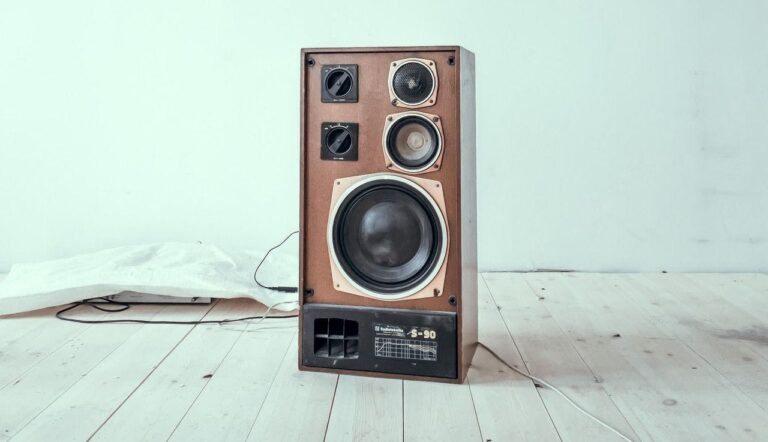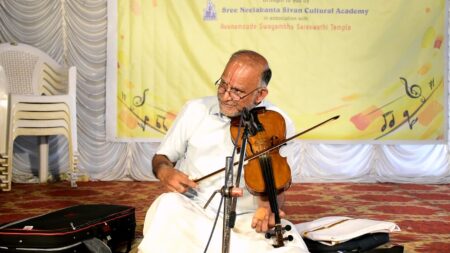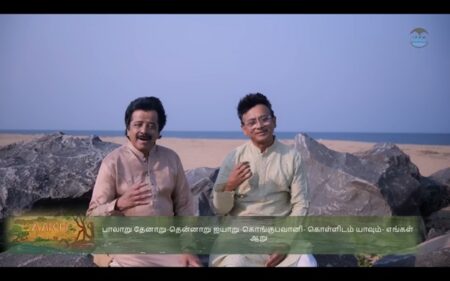Carnatic music and Hindustani music follow different sets of rules and yet blend together to form Bharatiya Sangeet.
Carnatic music and Hindustani music are the two pillars of Indian classical styles of music. There are several similarities between the two and many differences as well. Here’s a fictional conversation between two individuals advocating what makes each genre of music truly stand apart. As a student of both Hindustani and Carnatic music, this is my humble effort to make listeners of both systems appreciate the other system.
Sanjay: Oh, what a great performance!”
I said to my then-girlfriend, and now wife, T Lakshmi, after listening to a Carnatic maestro. I was a student of Hindustani music and hadn’t given any try to Carnatic music.
Lakshmi: Yes, Sanjay. I don’t know why some Hindustani musicians are prejudiced about Carnatic music. Our music is also, to quote your term, ‘Bharatiya Sangeet’.
Well, I assented. Since we were drawn towards each other by our mutual love for Indian classical music, we started attending both Hindustani and Carnatic concerts. After one such concert, while walking towards her home, we spoke about the differences in the styles of music.
Sanjay: Both Hindustani and Carnatic systems have the same 12 notes, and both are melody-centric. Moreover, the concepts of raga and tala are also applicable to both. Yet, they sound totally different. We often feel that Carnatic music is too fast, while our music is very soothing. Artists, at times, use too many syllables in a phrase. Also, there are many oscillations, which sound off-key to a Hindustani artist.
I knew I was in for a lengthy explanation.
Lakshmi (sounding angry): Oh, is it? Do you mean to say your music is perfect? Hindustani music has the habit of unnecessarily prolonging a raga rendition. Why are Hindustani musicians obsessed about rendering each and every raag for hours? When a Hindustani artist starts a raag in a very slow tempo, I take 3-5 minutes to figure out the raag the artist is rendering. You see, Carnatic music is so catchy, and we do not need an hour to show the full impact of a raga. We have kritis composed by saints, which makes the raga clearly ‘visible’. And then there is another concept of raag ‘samay’(time) in the Hindustani music genre, which puts constrains on one’s choice of ragas and we can hear only a few numbers of raags.
Sanjay: Ragas in the Hindustani music is slower because we believe that the raga reflects the three states of life – Utpatti (creation), Sthiti (sustenance), and Laya (end).” Just like we slowly introduce our different facades to others, as we get better acquainted, a raag also has to unfold leisurely.
Lakshmi: We also believe in this philosophy. However, we establish the raga in a phrase or two. Unlike in Hindustani music, Carnatic music gives equal importance to compositions as well. Talking of oscillations, we have a wide range of oscillation, which is unique to our Carnatic music. It can be noticed in a raga like Todi, where Ga and Ni oscillate between Chatushruti Rishabham, and Shuddha Madhyamam, and Chatushruti Dhaivatam, and Shadjam, respectively. However, neither of these notes are established, by staying on it. Our logic for such oscillation is that no note is foreign to a raga, provided it should be rendered in correct proportion with correct intensity and in a right voice modulation in order to enhance the beauty of the raga. By the way, Hindustani music also have something called Andolan?
Sanjay: Yes, we have Andolan. This can be noticed in raag Bhairav, where we oscillate the Rishabha, and Dhaivata, by gliding between the half preceding and one succeeding note, but end-up on the oscillated note itself, unlike Carnatic artists. We have another variety of this Andolan, which can be noticed in raag-s like Yaman, where Tivra Madhyam is oscillated with the help of only Pancham, as plain Tivra Madhyam sounds like the oppressing heat. Even while oscillating the Komal Gandhar in Miya Malhar, generally it is taken from Madhyam and shows the shade of Shudha Gandhar, unlike the Komal Ga of Darbari Kanada, which is taken from Shudha Re, to Ma and ultimately landing on the Ga itself
Lakshmi: Umm… now that you have explained it, I realise the depth of this oscillation in Hindustani as well. By the way, we also have small oscillation, which are used while singing ragas such as Kalyani or Hamsadhvani in which each note (except Sa and Pa, which are never oscillated) is oscillated and rendered plain as well.
As Sa and Pa, are the pillars of our music, the nearest notes like Sudha Rishabham and Kakali Nishadam (nearest to Sa), and Prati Madhyamam, and Sudha Dhaivatam (nearest to Pa), try to gravitate towards those pillars, so you will notice that, when we oscillate these notes, and they almost sound like Sa and Pa, as the case may be. Take the example of ma and ni in Kalyani Raga, or re and dha in Saveri Raga, and you will understand what I am saying.”
By now, we were deliberately walking slowly. When she talked, her voice sounded like music to my ears. So, I probed further into the nuances of both styles of music.
Sanjay: Hindustani style has multiple raag-s in one scale. For example, take the scale of shudha swaras without Pa, with Komal Re, and Tivra Ma. If we project Re and Dha, we get Marwa. In the same scale, if we project Ga and Ni, we have Puriya, and we project higher octave with high Sa, high Ga and little bit of Dha and Ni, we get Sohni. Another example can be that of Raag Megh and Madhmad Sarang (scale: Sa, Re, Ma, Pa, and Komal Ni), where oscillation is on Re and Ni, with the help of the succeeding note Ma and Sa gives Megh. All plain notes with emphasis on Ma gives Madhmadh Sarang.”
Lakshmi: Continuing on scale, Carnatic music’s Madhyamavati is more equivalent to Hindustani Madhmadh Sarang with different kind of oscillation on Ni, we get Vrindavana Saranga. Another example can be that of Suruti and Kedaragaula, or Arabhi and Devagandhari, or Reeti Gaula and Ananda Bhairavi. You see, even in Kalyani, the connection between Ni and Re, and Ma and Dha are used just like its Hindustani counterpart Yaman. Same can be said about Kafi and its Carnatic counterpart Kharaharapriya. Both systems keep on borrowing ragas from each other. For example, Carnatic ragas such as Abhogi, Hamsadhvani were adopted by Hindustani music. Hindustani raag-s such as Sindhu Bhairavi, Desh, Darbari Kanada were borrowed by Carnatic artists.
Sanjay: True. Our classical music is a fine example of unity in diversity. Long live India, and its music.
We had reached her home by now. I wished her good night. In due course, our lives would be linked forever. Hopefully soon those who assert musical superiority over other genres of music will forget the differences and come to appreciate it. After all, both genres of music fall under Bharatiya Sangeet.




